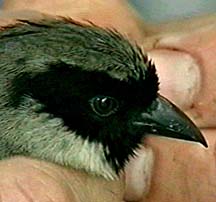Revisions essential to
Endangered Species Act
Targeted changes can help
boost its effectiveness
![]()

A po'ouli is shown in captivity. The last known po'ouli died last month.
Of the 1,200-plus species listed as endangered, only 14 have recovered sufficiently to be taken off the list. This is after 30 years of effort and hundreds of millions of dollars in costs. The track record for recovering endangered species needs to improve if we humans hope to preserve the biological diversity that blesses our planet.
Last weekend I attended a special Executive Summit with six other governors from western states to make recommendations on how to improve the current law and enhance the recovery of endangered species.
This summit was particularly important for Hawaii, since nearly one-quarter (312) of the 1,200-plus species listed as endangered by the federal government are found only in our islands. I had the opportunity to share some of Hawaii's success stories and hear first hand from other governors and congressional and federal decision-makers on what more they feel can be done.
There was noteworthy agreement at the summit that the federal Endangered Species Act can and must be improved. Conferees included noted environmentalists, scientists, academic experts, states' naturalists, private landowners, federal officials from the Department of Interior Fish and Wildlife Service, and key congressional staff as well as the congressman who heads the committee that will rewrite the law.
We focused on three essential changes:
Currently federal officials and courts put species on the endangered list and designate critical habitats for them to live in without providing clear criteria of how, when and under what circumstances the species can be taken off the list.
Without sound recovery goals, conservation efforts cannot be measured or reoriented toward better management practices.
» Second, states should be given a greater role in decisions to list species, designate critical habitats and develop recovery plans.
States possess broad trustee and police powers over fish and wildlife resources within our borders. We know first hand the local resources, science, habitat conditions and private individuals that can be brought together to help recover a species. Unfortunately, federal pre-emption practices and inflexible regulations have hampered the states in our efforts to improve recovery efforts.
» Third, the law needs to be revamped to provide incentives to states, local agencies and private landowners to assist in habitat preservation.
Incentives, such as grants or compensation for lost property, are particularly important given that approximately 80 percent of critical habitats involve privately owned land.
On the island of Hawaii we have successfully reared, relocated and released juvenile palila, to establish a second population of this rare species of Hawaiian honeycreeper found only on the slopes of Mauna Kea. We are establishing new populations of the endangered Mauna Kea silversword with the goal of outplanting 20,000 new plants by the end of 2005.
On Kauai we have successfully reintroduced the endangered puaiohi, the small Kauai thrush, back into the Alakai Swamp. And our efforts to raise and reintroduce the nene, the Hawaiian goose, our state bird, are looking so successful that it might be possible to declare this species "recovered" within the near future.
The single most important recovery effort my administration has launched is our initiative to combat invasive species. Biologists estimate that 36 percent of species extinctions have been caused by the invasion of non-native organisms into local habitats.
I will ask the Legislature this session to continue funding our multi-year, massive effort to eradicate animals, plants, insects, reptiles, amphibians (such as the coqui frog) and aquatic species that do not belong in our islands. They can have a devastating effect on native species and the quality of life.
This year alone I will be requesting $4 million for this essential effort. Further, we will continue to concentrate on programs to keep foreign species out. Toward this goal, we will ensure that 100 percent of flights from Guam are inspected for brown tree snakes.
This nation has demonstrated that we can improve our environment when we have the three essential features of clear goals, strong state participation and incentives to make the program work.
We have been able to make significant progress under other federal environmental statutes such as the Clean Water Act, the Clean Air Act, and the Superfund law. It is time to apply these same efforts on behalf of endangered species.
Improvements to the federal Endangered Species Act, along with vigorous state efforts such as the ones we are undertaking in Hawaii, can better accomplish our ultimate goals -- the recovery of endangered species and the preservation of our biological diversity. I am committed to working with our federal, local and private partners to make the changes needed to protect our aina.
www.hawaii.gov/gov/
[News] [Business] [Features] [Sports] [Editorial] [Do It Electric!]
[Classified Ads] [Search] [Subscribe] [Info] [Letter to Editor]
[Feedback]
